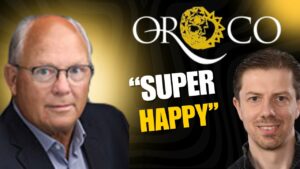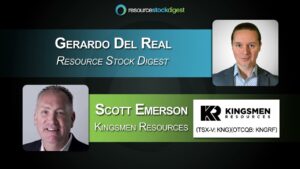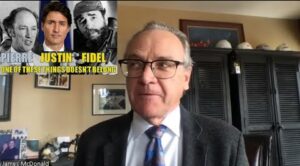Executives
Joseph Francis Conway – Chief Executive Officer, President, Director, Member of Disclosure Committee and Member of Health, Safety & Environmental Committee
Renaud Adams – Chief Operating Officer
David C. Blaiklock – Chief Financial Officer and Chairman of Disclosure Committee
Analysts
Rahul Paul – Canaccord Genuity, Research Division
Dan Rollins – RBC Capital Markets, LLC, Research Division
Jeff Killeen
Primero Mining (PPP) Q3 2013 Earnings Call November 6, 2013 11:00 AM ET
Operator
Hello, and welcome to today’s Q3 Results Conference Call. We have just a few announcements before we begin. [Operator Instructions] I will now turn the call over to Mr. Joseph Conway, President and CEO. Please go ahead, sir.
Joseph Francis Conway – Chief Executive Officer, President, Director, Member of Disclosure Committee and Member of Health, Safety & Environmental CommitteeThank you, operator, and for those on the line or on the web, thank you for your participation in our Q3 conference call. Anyway you look at Q3 for this year certainly has been a solid quarter for us, and I would like to on behalf of the shareholders, acknowledge the efforts of over operations, exploration and project development teams. They have done a great job in the quarter and I know that we can expect further good results as we go forward into 2014.
One of the key focuses we’ve had since we’ve put this company together a little over 3 years ago, was to show continuous improvement in terms of our production and our cost structure, and certainly Q3 marks a very high level on that. The next step change if you like is going to be the expansion to 2,500 tonnes a day at San Dimas which is going to be complete in Q1 of 2014, and then following that will certainly be the ongoing development of the Cerro Del Gallo project, which we acquired in May of this year.
I would– Just moving to the next slide, we will be making forward-looking statements, and I would caution — have you read the cautionary statement at your leisure. I’m going to carry most of the presentation, but Renaud and David as well as Louis and Gabriel are also here in the room to answer any questions of a technical nature as well.
So, moving on, certainly a record quarter. In terms of gold and silver production, we also enjoyed low-cash costs and low sustaining costs, our production guidance has also been increased, and I would note that we are now looking to produce 135,000 ounces to 140,000 ounces for the year. Costs are unchanged and likely in fact we will probably be at the lower end of that $620 to $640 level. We also enjoyed the highest silver sales ever on a spot basis largely due to our increasing throughput side of things.
Despite the following commodity price, particularly gold and silver, we did have robust earnings and cash flow and importantly for us our balance sheet remains strong.
We did report earlier in the quarter exploration results from Alexa and Victory as well as elsewhere and we’re very pleased with that and you can expect another quarterly update sometime later on this month. Importantly our capital programs are on track and subsequent to the quarter we did announce that we’ve consolidated our position in the Cerro del Gallo project. This is a structured deal, which has continued payments based on production decision as well as the gold price. The first payment is $8 million and that will likely be made during this quarter.
Turning to our operating results. Just to remind people, year-to-date we’ve produced about a 108,000 ounces on a gold equivalent basis. So when you look at our gold equivalent production, for third quarter of almost 42,000 ounces, you can see a significant impact. What’s been driving that is certainly the throughput — mill throughput and the grade. But I would highlight the fact that if you look at on a quarter-over-quarter basis from a 2012 to 2013, you are looking at a 64% increase in production, which is a good result, and we are very pleased with that obviously. What’s been driving it? Certainly, it’s been the gold grade. You’re looking at a little over 5 grams versus 3.4 grams last year. A lot of that can be a function of the fact that we are mining some high-grade pillar, but it was also the controlled dilution that we’ve gotten from the long-hole methodology that we have been using and elsewhere. Good results in terms of controlling dilution in particular. So the remainder of the year, we probably look at those 4.5 grams, and the consumer throughput from the mill.
Our Cost structure is also something we are very pleased about, again looking at it from year-over-year basis, going from $1,300 — almost $1,300 all-in sustaining basis to just under a $1,000, and on a cash costs basis from $700 to very close to $500. And importantly on a cash costs basis or byproduct basis closer from $360 down to $250. In any way you look at it in terms of a cost structure, we are certainly demonstrating that we’ve got operating leverage going forward.here.
What does that translate into in terms of financial results is significant. Despite the fact that the commodity price has dropped $200 on a year-over-year basis, our revenues are up almost 41%. If you look at our earnings from operations, we’re up almost 75%. So that’s clearly demonstrating to us that the operating leverage is working. I will look at –If you look at our net income, it is essentially flat, largely because of our recovery taxes in Q3 of 2012 and a tax expense in Q3 of 2013.
But, however, if we look at the adjusted net income, which really excludes the impact of foreign exchange and deferred tax balances, you are seeing an almost 300% increase on an adjusted income basis and on an EPS adjusted basis a 200% increase. And that’s largely a function of — the difference there is a function of fact that we did issue shares in 2013 to acquire Cerro Del Gallo project.
Operating cash flows, $20 million versus — below the $20 million, just under around $15 million. So a good result going forward from there.
When we look at our outlook for this year, you will note we’ve revised it, and this is actually the second time that we’ve revised it. We’re now seeing about 135,000 to 140,000 ounces of gold-equivalent production and that’s largely driven by the gold production just going from 105,000 to 110,000 what we see currently.
Spot – the silver production is relatively flat and our cost structure, as I mentioned earlier, is also essentially flat. However, what we do see this upper revision clearly demonstrates to us at least that numerous productivity improvements that we’ve put in place are already returning an investment and this will continue in 2014 and beyond.
Our focus remains on basically 5 elements of our business. Certainly we want to maintain our strong balance sheet, that’s an important critical part for our business, we want to able to demonstrate measured growth, and we want to able to demonstrate disciplined cost management. When we look at cost management, we look at largely through long-term, productivity improvements, rather than potential short-term cost cutting measures. We want to continue to build our business in low risk jurisdictions, and we wanted to be noted as a responsible miner.
We’ve won a number of awards over the last several years to attest to that responsible mining, however, we want — that’s going to be a big part of us going forward is using that as we build new projects.
When you look at our growth profile, we haven’t given full guidance for 2014 yet, but it will be in that range of 150,000 to 170,000 ounces. If we look at 2015, 160,000 to 200 000 reflects the possibility of a 300,000 tonne a day expansion and then when we look beyond that, 2016 is where we see the Cerro Del Gallo project coming in for a full year.
We are obviously looking at the other opportunities of a similar scale and that our target really as an objective, at least, is to get 2016 producing 400,000 to 500,000 ounces per year level. How we are going to do that is certainly going to be a function of our strong financial position. At our cash position of $126 million, it’s essentially unchanged from Q2 despite significant capital outflows to expand our business. You will note that, we see about $90 million of after-tax cash flow on a 5-year basis. This is based on a $1,200 gold price and does reflect the recent tax reforms that have been in place in Mexico. And bear in mind that $90 million that we talk about excludes the Cerro Del Gallo and excludes a 300,000 tonne a day scenario that’s possible at San Dimas itself.
We’re also looking to increase our financial flexibility in other ways. We’ve been in dialogue for a period of time now to establish a credit facility and we expect that, that’s going to occur probably during this quarter. So, we certainly have enough funds to build what we own and with no shareholder dilution and we also think that we — with that financial flexibility that we will have with a line of credit we will be able to look at opportunities beyond just what we own currently today.
When we look at our assets, that are key assets at least, which is certainly San Dimas and Cerro Del Gallo project. There is a great deal of commonality. Both of them are in historical mining districts that have been operating for literally hundreds of years, both have established infrastructure in terms of physical infrastructure, but as well skilled workforces and local suppliers and importantly we enjoy good local support in terms of our mining activities.
When we look where we’re going from here, we see steady growth ahead, yet we are targeting to double production by 2016 from our current levels. The platform is certainly San Dimas and the first near-term catalyst if you like is the expansion of 2500 tonnes a day, the next day well be the 3,000 tonne a day scenario at San Dimas and then last but not least the certainly the ongoing — the development and operation of the Cerro Del Gallo project.
So just to touch on San Dimas, initially that is our flagship asset. Its a conventional underground mine, 600,000 ounces or so in reserves and a 1.5 million ounces in measured and indicated resources. This mine has had a long history of reserve and resource replacement, and whether you look at the long-term history or whether even the recent history of under the ownership of Primero the dedication of capital to exploration is been a key approach that we see to improve the value of this operation in general.
San Dimas also has a very low cost structure, and in fact below industry average cost structure. One of the things you will note that we’ve talked about over the last 18 months or so, is really the idea of number of strategic operating initiatives that we began really in 2012. I would say, there are not — still not fully reflected in our operating cost structure today, but where we have made them clear improvements certainly on the optimization side in terms of the mill throughput, the long-hole mining which was a part of that program has come in and not only increased our production, it’s always had a big impact on our dilution. And certainly last but not least is a big focus on training. That’s gone a long way for us in terms of the productivity and quality control in general, particularly in the drilling and the maintenance side of the business.
For 2014, we expect further cost improvements and we’ll detail those cost initiatives in January of 2014, when we put out our guidance for that period.
Touching on the San Dimas expansion. We are on track to achieve the 2,500 tonne a day in Q1, for roughly the same capital of about $16.5 million. We have continued to look at the opportunity to go to 3,000 tonne a day. We — at this point, the critical part of that decision is really ensuring that we have sufficient underground development and exploration success that we can maintain at 3,000 tonne a day for the long-term.
I think we are not in the position frankly today, but I do see this as a when not a if, and I will give you a little more detail about why we feel very comfortable about that. When we look at what we’re doing from, what I call, a strategic underground development point of view, we’re driving if you note on this section through here, we have a line a green line through bottom of that slide and that slide is really an underground development tunnel, a lower tunnel if you like that’s going to be complete by the end of 2015. And the importance of that is that both of those — that tunnel is really very close to, for example to the, Alexa and Victoria veins which are continuing to grow in terms of resource ounces, particularly since beginning of this year. So the idea here is really if we can access the mineralization that we see here today from 2 different levels that will give us sufficient working phases to match — to go to the 3,000 tonne a day scenario. So again it is a when, not a if.
Little bit more detailed on our exploration side of it, as you know, when we bought here, the original plans were just to do a lot more drilling from exploration from surface, we’ve taken a strategic view of driving a tunnel perpendicular to the main mineralization and that has continued to show benefits year-in and year-out. What we’re seeing now for example is, as you recall, we did make a discovery in the Alexa and Victoria veins; during the quarter, we’ve expanded those. We’ve also identified some mineralization in the San Jose Area, which is in the middle of the page and that’s again is very close to infrastructure. And the importance of that — driving that and looking around the infrastructure is you can very quickly go from to a discovery, to a resource and have it into production and within a very short period of time.
A case in point, the survey the new mineralization that we found at Alexa and Victoria. We discovered that in early 2012, already this year has contributed about 8% of our production tonnes and we’ve expanded the footprint of that significantly even in the last 6 to 12 months.
I would draw your line — you notice if you like to the bottom right-hand corner where you will see those green dots, those are the planned drilling for the remainder of this year, and again we’re very confident that this area is going to continue be an important part of our production profile in the future.
Turning to the Cerro Del Gallo project, which is our new mine — new development project. We now own — will shortly own 100%, as I noted earlier, with the agreement with silver — with Goldcorp.
The simple process, open pit, heap leach, ultimately there maybe a mill but we’re, at this point, focused on running a heap leach operation only. Certainly the key characteristics here is again excellent infrastructure. We’ve got a mine — this is one of the most active mining districts in Mexico, availability of skilled workforce, grid power and equipment supplies are probably one of the best in terms of Mexico and importantly you’ve got a community that supports mining in general. If you note the whole area has produced over a 1 billion ounces of silver in the last 450 years. The important thing for us though is that this diversifies our near-term production over the next few years and it doubles our reserves.
When we look at Cerro Del Gallo from a production point of view, as I noted, it is a heap leach scenario, and this is a quick diagram of where we stand with that. There is a measured indicator resource of about 3.2 million or 5.6 million on a gold equivalent basis and clearly a lot of over the medium-term is going to see if we can optimize this project and obviously capture more of those resources through the production cycle of the mine.
Looking at the economics, again based on the, say prices where we are today, you’re looking at reserves of about 1.2 million ounces and indicated resources of about 1.6 ounces.
Capital estimate as of May 2012, is roughly $165 million. We are clearly reviewing and aggressively trying to focus on capital reduction within this program, particularly given the change in commodity prices since we acquired this asset as well as a change in taxation in Mexico generally.
We are spending about $15 million including about $4 million on exploration there during this year.
Basically, when we look — what we will do for our production plan is really take us — it will add about 60% of production to us, and you can see this is what we see today, there is basically an 8-year mine life starting in 2016 and — but we are going to be looking to extend the mine life and perhaps even find more mineralization through a fairly aggressive exploration program beginning this year.
Looking at the exploration, a modest investment this year, again largely because we’ve acquired it in May, basically a $4 million budget. But it’s important to note that there has been no activity in terms of regional or otherwise in terms of exploration since 2008. There’ll be a 12,000 metre infill and condemnation program, which may — we may uncover additional mineralization there. But there is a lot of known mineralization outside the existing development plan, which is that rig is the center of that slide on to the right. Our current focus is really on condemnation drilling, permitting, land acquisition and an engineering update, so that we can make a decision at or around the end of this year in terms of production.
In terms of our corporate activity, very much focused on what we call low-risk jurisdictions. You will note on the right the regions of focus, and you can clearly see certainly a lot of countries, particularly Venezuela, Argentina and elsewhere are not places that were preparing to do business. We are trying to focus on diversification of our asset base and ultimately build a portfolio of early and advanced stage projects.
But we are focused only on mining friendly jurisdictions and only those that have established infrastructure. I think we’re all aware of those in this industry where trying to build projects in remote areas can be quite challenging.
In terms of target scale, we’re looking for something probably in the order of San Dimas, call it 100,000 to 150,000 ounces of production a year. And again I think, we are relatively unique and that we have a very strong balance sheet and as well as cash flow and we intend to use that opportunistic to have accretive acquisitions in the future if we can find them.
So really to summarize, there is — clearly we see Primero is an opportunity and something to look at from an investment point of view very strongly. We are an emerging mid-tier player with a porfolio of long-life and high-grade assets, we’ve got a track record of steady, dependable growth and certainly also a track record of controlling our costs.
And last but not least, certainly the strong cash flow and cash position which funds all of our organic activities and perhaps other activities as well.
So with that, I will turn it back to the operator. I thank you for your attention and certainly we are open for questions.
Question-and-Answer Session
Operator
[Operator Instructions] Our first question is from Rahul Paul.
Rahul Paul – Canaccord Genuity, Research DivisionYou indicated that the higher-than-expected grades were partly to do with lower dilution as a result of the conversion to long-hole and other optimizations, how much mining dilution are you seeing now versus what is built into your reserve trade?
Joseph Francis Conway – Chief Executive Officer, President, Director, Member of Disclosure Committee and Member of Health, Safety & Environmental CommitteeRenaud?
Renaud Adams – Chief Operating OfficerYes, thank you, Joe. Well, Rahul, I would say that if you look at the overall mining, there are some areas that are a little bit more complicated to maintain on the survey basis, but I’m very comfortable to say that we can overall mine below 35% or in a range of 35% overall.
Rahul Paul – Canaccord Genuity, Research DivisionHow does that compare with what you had modeled in your reserves?
Renaud Adams – Chief Operating OfficerWell, the current reserve 2012, in December 2012, is overall 58%. But just want to remind that the reserves are only based on 18 veins that are away [ph] from the Central block and the Graben block, does not include some of veins that we are currently mining in Tayoltita. So I would say, if you take everything into account, we’ll probably be more like in the 50%. And that’s add to about 35% that we are achieving now. So we will be, at the end of the year, incorporating all the new vein, while adjusting the dilution as well and everything will be, I would say, reinstated in January or around January.
Rahul Paul – Canaccord Genuity, Research DivisionOkay, that’s awesome. And then just moving on, at how much money did you spend at Cerro Del Gallo in Q3 and how much of the $15 million budget is left to be spent in Q4?
Joseph Francis Conway – Chief Executive Officer, President, Director, Member of Disclosure Committee and Member of Health, Safety & Environmental CommitteeI think we’re on track in terms of what our expenditure is, and I’m going to guess in the order of about $4 million or $5 million. Sorry, am I being corrected here. Go ahead.
Renaud Adams – Chief Operating OfficerI would say overall on the total of $15.4 million, we are expecting probably maybe $4 million, $4.5 million that would be forward– carryforward in the early 2014 to complete.
Joseph Francis Conway – Chief Executive Officer, President, Director, Member of Disclosure Committee and Member of Health, Safety & Environmental CommitteeSo we will do 10 by the end of year.
Renaud Adams – Chief Operating Officerabout 10 by the end of the year.Yes.
Rahul Paul – Canaccord Genuity, Research DivisionAnd how much did you spend in Q3?
Joseph Francis Conway – Chief Executive Officer, President, Director, Member of Disclosure Committee and Member of Health, Safety & Environmental CommitteeWe spent in cash about $4 million and committed about $7 million.
Unknown Executive
Largely that will be.
Joseph Francis Conway – Chief Executive Officer, President, Director, Member of Disclosure Committee and Member of Health, Safety & Environmental Committeeand also in exploration.
Rahul Paul – Canaccord Genuity, Research DivisionOkay. Is that all being capitalized or some of it being expensed as well?
David C. Blaiklock – Chief Financial Officer and Chairman of Disclosure CommitteeIts being capitalized. It’s David Blaiklock here.
Operator
[Operator Instructions] Our next question comes from Dan Rollins.
Dan Rollins – RBC Capital Markets, LLC, Research DivisionMaybe, Renaud, could you talk about how much — what proportion of the underground right now is being mined using long-hole, and where you potentially see that percentage rising to over the next couple of years and should we expect to see a significant difference in mining costs as you increase or is it that really just similar mining cost but better dilution?
Renaud Adams – Chief Operating OfficerThe whole story and in the semi-short version, I would say, we have — we haven’t attempts as much as we wanted in the third quarter, but still if you look at on a drilling basis, about 20% of the total tonnes, we did have some basic issues on our capacity to load and last as fast as we’re drilling. So as a result of that, we have a bit like 45,000 to 50,000 tonnes of inventory drilled inside the mine. So about 20% on the drilling basis, but about 12% to 15% on blasting basis. We’re correcting the situation, we are ordering now the appropriate equipment and for land loaders that will be attached to the long-hole. And I would say once we correct that, we will ramp up to the next 30%. We’re seeing in the short term about 30% for the next year on the total long-haul contribution.
We are going to complete very shortly a new planning — mid long-term planning, and we’re really targeting to push that long-hole in the midterm to by over 40%. But we see — we see definitely a 30% achievable next year and eventually try to overall push beyond the 40%. What will be potentially the impact, there is the– we see in the short-term a possibility to reduce anywhere between $5 to $10 tonne based on just the long-hole percentage per se, and automatization. So when you take everything into account and eventually when we will do long-hole by ourself, there is probably a possibility to, I would say, before inflation anywhere around maybe $10 a ton.
Dan Rollins – RBC Capital Markets, LLC, Research DivisionOkay, so basically, maybe a little bit of savings next year as you ramp up but more importantly as you guys…
Joseph Francis Conway – Chief Executive Officer, President, Director, Member of Disclosure Committee and Member of Health, Safety & Environmental CommitteeWe’re definitely going to push on a cost reductions next year.
Dan Rollins – RBC Capital Markets, LLC, Research DivisionExcellent, and to go to 3,000 tonnes a day. Is there I was wondering if you want to see more reserves resources, is there a sort of a set amount of reserves you want to have in inventory ahead of you that you can get comfortable running a 3,000 tonne a day. Is it 1 year, 2 year, 3, 5 years?
Renaud Adams – Chief Operating OfficerWe always like to see at least like a 3, 4 years of solid mine plans ahead of us. We’re really looking at this 3,000 tonnes per day not just as — further next step, but as a kind of an overall optimization as well in maximizing long-hole — maximizing the hauling as well, remember we’re transiting to the western part of the mine. We need to optimize our hauling, we are as Joe, mentioned connecting the blocks as well. Putting all the infrastructure in place to maximize, its probably in the range of anywhere between 12 and 24 months. You’re right that we would like to see uses for matching this — those efforts with the exploration as well. We’re just I would say taking a very cautious to know to balance and optimize, I dont have the specific dates, but we’re very confident, as we move forward we will keep increasing capacity of this month.
Operator
Our next question comes from Jeff Killeen.
Jeff KilleenJust wondering you did allude to I think Joe the grades and how they’re going to respond in Q4 and going into next year should fallback sort of in the 4.5-gram range. Do you think that, that’s going to be staggard decrease from what you’ve seen here in Q3 or is it kind of the more of a sharp decline? And an extension to that, do you think that we could see positive pops in the grade like this due to pillar recovery periodically whether next year or going forward?
Joseph Francis Conway – Chief Executive Officer, President, Director, Member of Disclosure Committee and Member of Health, Safety & Environmental Committeeyes, there is certainly some of that could occur — there is going to be ongoing pillar recovery, but Renaud, why dont you?
Renaud Adams – Chief Operating OfficerIf you recall last year, we had a bit of a complication in the third quarter and 2 things happened and one of it was we couldnt recover at the level, we adjusted our metrics, we adapted also the long-hole to some pillar recovery. We prepared a new zones in a different way. So you put all that into consideration. And to the Q3, we’ve recovered some very good pillars and some very old part of the mine. We were probably maybe on the conservative side I guess to our full success and recovering those pillar and degrade that the reserve we are showing. And I must say that we’ve been very successful, we’ve recovered also large we needed to recover in the Q3, if any even a bit, I would say, the dilution on it. So as a result of that, nearly 6,000 ounces has been, I would say, in excess of what we originally planned and we are reporting the guidance for the year. Moving forward, if you look at the quarter Q3, we were in average of 4.3 Coming out from 4.1 and 4.3, and we keep improving. Year-to-date is about 4.5 and as we move forward, we’re going to keep working on dilution and improving our methods and I will be very happy if we maintain as Joe said, our 4.5 in Q4, which will be another first step for to further from our Q2 without taking into account the very high-grade pillar. So we will be keeping mining pillars next year, will be distributed in our mine plan to balance our mine plan. We are not ready to disclose any number, we’re just working on the mine plan and optimization. But we see definitely pillars as part of our mine plan at least for the next 2 years.
Jeff KilleenOkay. Great, thanks, and I’m just wondering if you might be able to more specifically outline what the capital spending for San Dimas might look like for Q4 and in the next year?
Joseph Francis Conway – Chief Executive Officer, President, Director, Member of Disclosure Committee and Member of Health, Safety & Environmental CommitteeDavid, you have all figures. I mean, we have the — we have our guidance for the year on CapEx, I don’t have the figures in front of me, but…
David C. Blaiklock – Chief Financial Officer and Chairman of Disclosure CommitteeIt’s $4 million to $6 million basically, that’s going to remain the same. I would assume — I think you could probably assume a similar level of capital next year.
Unknown Executive
We have a couple of projects that span 2 years, so for example the 2,500 tonne a day goes into next year as well; the beginning of the next year the Truchas expansion goes into the game next year and the wastepad build out goes into next year. So our CapEx next year will be roughly the same as this year and then it should decline after that.
David C. Blaiklock – Chief Financial Officer and Chairman of Disclosure CommitteeWe’re probably still contribute $15 million to exploration, so that’s built into that number, just to be clear. So its big part of where we’re going to go forward.
Jeff KilleenAnd final question just on the financing opportunities you have here and talking around M&A, is there something specific that you’ve been may be contemplating that this could be allocated for or is it more just a precursory type of financing to give you options?
Joseph Francis Conway – Chief Executive Officer, President, Director, Member of Disclosure Committee and Member of Health, Safety & Environmental CommitteeI would say it’s more kind of enhancing our liquidity generally. That’s in terms of the use of proceeds, there is nothing on the horizon at this moment. But we will continue to look obviously. But really its around making sure we have maximum substantial flexibility.
Operator
And that was our last question.
Joseph Francis Conway – Chief Executive Officer, President, Director, Member of Disclosure Committee and Member of Health, Safety & Environmental CommitteeAgain thank you for participating in the call. And we look forward to updating you where we are for 2014 and what our reserves and resources in particular are going to look like as we go forward. And once again, thank you.
Operator
Ladies and gentlemen, we thank you for your time and attention. This webcast is now concluded.
Copyright policy: All transcripts on this site are the copyright of Seeking Alpha. However, we view them as an important resource for bloggers and journalists, and are excited to contribute to the democratization of financial information on the Internet. (Until now investors have had to pay thousands of dollars in subscription fees for transcripts.) So our reproduction policy is as follows: You may quote up to 400 words of any transcript on the condition that you attribute the transcript to Seeking Alpha and either link to the original transcript or to www.SeekingAlpha.com. All other use is prohibited.
THE INFORMATION CONTAINED HERE IS A TEXTUAL REPRESENTATION OF THE APPLICABLE COMPANY’S CONFERENCE CALL, CONFERENCE PRESENTATION OR OTHER AUDIO PRESENTATION, AND WHILE EFFORTS ARE MADE TO PROVIDE AN ACCURATE TRANSCRIPTION, THERE MAY BE MATERIAL ERRORS, OMISSIONS, OR INACCURACIES IN THE REPORTING OF THE SUBSTANCE OF THE AUDIO PRESENTATIONS. IN NO WAY DOES SEEKING ALPHA ASSUME ANY RESPONSIBILITY FOR ANY INVESTMENT OR OTHER DECISIONS MADE BASED UPON THE INFORMATION PROVIDED ON THIS WEB SITE OR IN ANY TRANSCRIPT. USERS ARE ADVISED TO REVIEW THE APPLICABLE COMPANY’S AUDIO PRESENTATION ITSELF AND THE APPLICABLE COMPANY’S SEC FILINGS BEFORE MAKING ANY INVESTMENT OR OTHER DECISIONS.

















